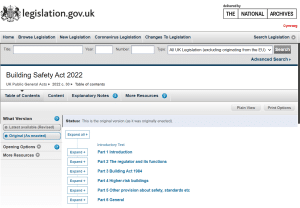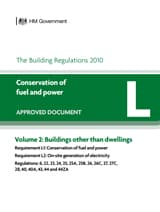The Building Safety Act, which came into force in 2022, will take some time to make its presence felt, but will eventually have a profound impact on all parts of the building services supply chain, says Sales Director Liam Elmore.
It took five years of soul-searching and recrimination following the Grenfell Tower disaster before the Building Safety Act was voted into law and it will take a few more years before the new legislation achieves its overall aim to transform the culture of construction.

However, its long-term impact will be extremely far-reaching. Many in the industry still do not fully appreciate how significant this will be, wrongly assuming it is just about high-rise, high-risk buildings (HRBs), but it is, in fact, about any project, in any building, that requires a safety notice.
There are additional implications for high-risk buildings in the shape of a new Gateway planning system that means designs are scrutinised at different stages before work can continue, but the overall ambition of the regulators to improve competence and communication reaches right across the industry.
In any case, many building services companies of all sizes regularly of work on HRBs at various stages including a lot of small businesses who carry out maintenance, repair, and modification work – all of which will be classified as high-risk projects by the newly appointed Building Safety Regulator, therefore, bringing them into the scope of the Act.
Competence
The legislation establishes a ‘competence framework’ to underpin its ambition to ensure only people with the right (and relevant) skills can work on construction projects – and clients have clear responsibilities to only appoint competent companies.
It also calls for a huge improvement in the way information is shared between all parties, particularly during the early stages of a project, using the so-called ‘Golden Thread’ principle. This will be crucial to delivering one of the legislation’s most important ambitions – to preserve the integrity of designs.
The Act does not prohibit changes but seeks to ensure they are not made in an arbitrary way simply to save money. As this article was being finalised, the finer details of the secondary legislation were being hammered out, but a top priority was to put a process in place to help the Regulator distinguish between necessary and what might be called ‘mischievous’ changes.
By the same token, it is important that the new rigorous enforcement powers provided by the Act and that carry criminal sanctions do not end up with some people being prosecuted unfairly – avoiding unintended consequences that could lead to unfair and disproportionate punishments. Better enforcement is vital, of course, but it needs to be proportionate and not all changes to designs are made by people trying to duck compliance – often specifications are simply impractical.
However, we do need to get away from the current ‘patchy’ enforcement of Building Regulations. Part L, in particular, has widely failed to drive home the hoped-for energy efficiency changes. You could also argue that the Grenfell Tower fire was the result of people not meeting the requirements of Part B.

Our experience during the pandemic also showed that we have singularly failed to meet Part F’s ambitions for proper ventilation in buildings – so the fact that these key regulations were also updated in 2022 is significant.
We are starting to see a more co-ordinated approach to meeting and enforcing better standards right across the piece, but the Act also raises a very important question: “Who is the designer?” because this has significant implications for assigning responsibility.
There is a big debate going on about what this means for manufacturers. You could argue that as soon as someone in our sales office offers advice to a contractor about the use of our equipment, they take on the role of the designer for that project. That appears to be what the legislation now says.
This is a very hard thing to regulate, particularly if we are only offering what might be described as ‘general advice’ not something prescriptive and site-specific. However, manufacturers should not be looking to duck their responsibilities.
We will have to be ready to be challenged sometime in the future if a safety issue is flagged up and be able to defend our position – along with everyone else in the supply chain. That can be seen as a positive thing and should, in the main, reflect how we are already working.
Handover
At Lochinvar, we provide free of charge pre-installation technical visits to ensure the client is fully briefed and any possible on-site complications are flagged up before our equipment arrives. Client liaison is crucial at the design and pre-commissioning stages to pave the way for a smooth installation and handover – and we take that aspect of our service very seriously.
Potential issues around site access and suitability should be ironed out before equipment is delivered and our project engineers are happy to share their experience with our clients. It adds value to what we offer and reduces the risk of projects being delayed and additional costs.
It is also important that enough time is allowed for commissioning, and this is also being enshrined in the legislation with the Regulator expected to come down hard on duty holders if this important period has been sacrificed. After all, contractors could argue, legitimately, that they were not given enough time to make sure the installation was compliant.
To ensure we can meet the goals of the legislation, it is important to change the culture around commissioning too. It is not just a ‘tail end Charlie’ task but should be considered from the outset so that important considerations like ease of access to the equipment is included in the design and comprehensive technical information is passed on to the commissioning team.
This not only helps with ensuring it is safe, but also means the pieces are in place for ongoing service and maintenance to support better long-term building performance. Sharing our expertise means a manufacturer will improve the quality of an installation – both at handover and through its operating life – for everyone’s benefit whether it is a legislative requirement or not.
A more joined up process is more important than ever because commissioning engineers are being asked to carry out increasingly complex tasks. They are at the forefront of the low carbon heat market with the growing specification of heat pumps a key area.
Working with the manufacturer is a good way of achieving commissioning aims because they have intimate knowledge of their products, and their commissioning engineers will already have experienced most of the technical challenges they are likely to meet.
For example, the service and commissioning team at Lochinvar can set up boilers and water heaters to operate at maximum efficiency from day one and can spot potential problems quickly because of their detailed knowledge. They will also issue a commissioning report, which is a valuable resource for facilities managers charged with keeping the system operating close to optimum throughout the building’s lifecycle – and not ensure compliance with the relevant regulations.
We also offer three free-of-charge design and commissioning visits to every heat pump installation and can provide on-site training which will also help ensure installations are compliant and are set up properly to work well throughout their operating lifetime.
The same thing will apply to refurbishment and retrofit and the fact that the legislation is so specific about the need for a proper commissioning period is very welcome. This will be to the benefit of everyone as it will be reflected in more efficient long-term performance and efficiency – not just safety.
The protection and peace of mind provided by the warranty is another important consideration for an end user. If a manufacturer has been appointed to carry out the commissioning, the warranty period usually starts at that date, but this may not be the case when commissioning is carried out by a third party.
In these instances, the manufacturer’s warranty may start from the date the product is supplied and we expect the requirements of the Act will make this even more attractive to clients.
In the end, however, this is not just about sticking to safety rules. It is also about our industry providing a better all-round service to clients and their supply chains, which is something we should all aspire to – safety should be a given.
Do you have a project you would like to discuss with us? If so head over to our Sales Team contact page to get in touch with your local Area Sales Manager.